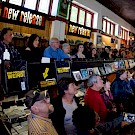 You’ve heard that streaming will save the music industry. You’ve also heard that it will be the death of indie artists. Vinyl has made a comeback; but the digital download is still big. So, how are people actually getting their music in 2016? On the latest episode of The Future of What, we discuss the way people are consuming music with three authorities in the business: MusicWatch’s Russ Crupnick, the founder of Tommy Boy Entertainment, Tom Silverman, and Jim Lidestri, CEO of BuzzAngle Music.
You’ve heard that streaming will save the music industry. You’ve also heard that it will be the death of indie artists. Vinyl has made a comeback; but the digital download is still big. So, how are people actually getting their music in 2016? On the latest episode of The Future of What, we discuss the way people are consuming music with three authorities in the business: MusicWatch’s Russ Crupnick, the founder of Tommy Boy Entertainment, Tom Silverman, and Jim Lidestri, CEO of BuzzAngle Music.
“We hear so much from artists, or executives, or other kinds of experts, often we don’t hear enough from the actual consumers,” Russ Crupnick, managing partner at the music marketing research and analysis agency MusicWatch, tells us. Crupnick speaks on the behalf of music consumers, which he feels are generally absent from the conversation.
So how are music consumers behaving in 2016? “It’s a story of diversity and choice,” he says. “It’s surprising how many different ways people have of consuming music.” According to Crupnick—and contrary to a lot of industry rhetoric—ad-based streaming and piracy aren’t taking up the most space in today’s market. “There’s a lot of conversation that people don’t buy music anymore,” Crupnick says. “Nothing could be further from the truth.”
To get a better sense of consumption patterns, we talk with Jim Lidestri, CEO of the new music analytics service BuzzAngle Music. Rather than focusing on the top few albums in the country, BuzzAngle “measures all of the true consumption that happens: physical sales, albums, digital sales and digital streaming,” Lidestri says. By taking into account the diverse platforms of music sales and consumption and offering daily personalized charts, BuzzAngle aims to bring the industry up to date and provide a realistic picture of the market for all artists.
 What does this breakthrough technology tell us about music trends? “Over the last year and a half, we saw the doubling of streaming consumption,” Lidestri says. “What we’re seeing now is more tremendous growth on the subscription audio streaming side of the equation, which should be very favorable for the indie artist.”
What does this breakthrough technology tell us about music trends? “Over the last year and a half, we saw the doubling of streaming consumption,” Lidestri says. “What we’re seeing now is more tremendous growth on the subscription audio streaming side of the equation, which should be very favorable for the indie artist.”
Tom Silverman, founder of electronic and hip-hop label Tommy Boy Entertainment, echoes Lidestri’s emphasis on subscription-based streaming, but begins by setting the record straight on digital downloads. “In America, the biggest net revenue to the industry is still digital downloads, then physical records,” he explains. But, certain forms of streaming could be means to a lucrative future for the business. “There are six different revenue centers in the business... they all drive different amounts of revenue, both on a per listen basis and also on a per user basis, which we call ARPU (average revenue per user),” Silverman explains. These areas are not mutually exclusive for consumers, he says, “they’re additive.”
Silverman sees hope in emphasizing the highest ARPU, and, he says, “it just turns out that subscription is the highest ARPU. So how do we drive people to subscribe to a music service? Because that’s where we’re going to grow the business.”
Lidestri is already seeing this happen. “There’s been a lot of talk about getting that average revenue per user up,” he notes. “One way to do it is to get the consumption higher for the subscription-based streaming, and we are actually seeing those trends happening right now, so we’re very excited.”
This episode features music by:
Marnie Stern: “Nothing Is Easy”
Boats: “Great Skulls”
Explode Into Colors: “Eyes Hands Mouth”








